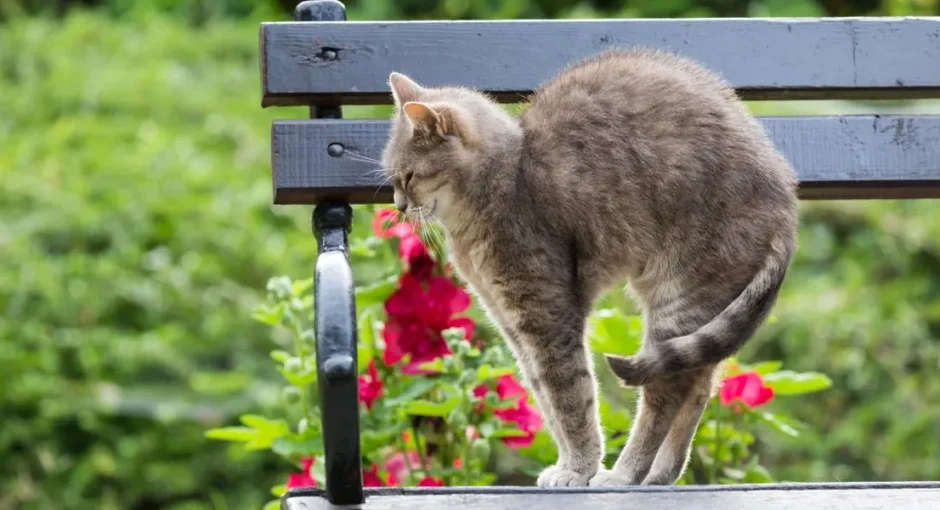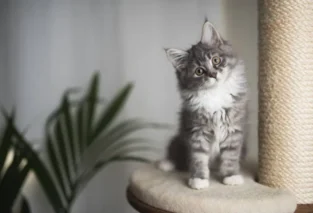Cats can rotate and twist their spines unlike any other animal. You have probably noticed your cat in an arched position while scratching or stretching, but did you know they may also curve their spine when they’re happy, angry, stressed, frightened, or in pain?
Here, we explore why cats arch their backs and the meaning of this enigmatic body stance.
8 Reasons Why Cats Arch Their Back
A cat may arch their back due to several behavioral and physiological reasons:
1. Your Cat Is Stretching
Cats have elegant bodies and elongated spines, which they need to flex and extend to keep their tendons and muscles in top shape. Stretching is a normal cat activity that regularly takes place when your cat first wakes up or after a period of rest. Stretching is usually accompanied by yawning.
Cats can stretch either from a standing position by extending their forelimbs forward and drawing their body toward their rear legs, or by extending all four limbs while upright and arching their back, seeming to stand on tiptoe as their legs extend.
Similar to humans, stretching consists of an extension of the limbs, back, and neck. Stretching improves flexibility, increases circulation and blood flow, flushes toxins from the body, and prepares a cat for pouncing after moderate inactivity.
2. They Sense Danger

The “Halloween cat” pose is a clear sign that your cat is afraid.
Your gentle domestic cat is instinctively predisposed to fear. Most cats are quite alert. They can sense danger a mile away, constantly ready to go into a state of anxiety in response to being surprised or restrained, when displaced from home, or when they perceive a threat.
The “Halloween cat” pose is the classic example of fear in cats. It happens when your cat stands in a tilted posture with their rear highly arched, their feet close, their hair raised up in piloerection (hair standing up), their eyes staring with dilated pupils, and their mouth partly open.
Also Read: Are Multi-Cat Households More Stressful?
Avoid approaching or touching your cat when they are frightened or distressed since you’ll exacerbate their anxiety level.
3. They Are Happy or Excited
One of the cutest reasons cats arch their back is when they’re feeling excited or happy. One of my favorite times of the day with my cat is mealtime. This is when Simba will approach me with his tail high up, quivering it like a rattlesnake, and his back arched as he rubs against me in anticipation.
You can tell when your cat arches their back due to happiness or pleasure. They will behave in an exceedingly relaxed manner, purr, rub against you, head-butt you, and follow or sit beside you.
4. Your Cat Is Warning Other Animals to Beware

Cats might arch their backs with hair standing up to warn off potential foes.
Your cat may display distance-increasing signals when neighboring cats or dogs are nearby. Their positioning sends the message, “Don’t come any closer.” Usually, this behavior arises when your cat feels that they, their territory, or resources are in danger.
Typically, when a cat feels threatened and they are warning off an intruder, they will attempt to appear as large as possible by displaying piloerection along the spine and on the tail, standing upright with straight legs on their tiptoes, and arching their back. Your cat might also turn their body to the side and rotate their ears forward or backward. This is a common response to a territory invader, which you can take note of to see if there are other animals around.
5. They Are Ready to Play
Play behavior is common amongst kittens and you’ll definitely know your cat is happy when they display some of the following play behaviors:
- Side-step: The cat soliciting play will move toward another cat side-on with their body arched and their tail in an upward curl. They may also circle around the other cat and approach their prospective playmate sideways.
- Horizontal leap: More commonly referred to as “crab walk” and usually witnessed in kittens, a cat will demonstrate the posture associated with side-step play, but suddenly leap off the ground with an arched back. Play may either be social or object-directed at a favorite toy, a sibling, a dog, or a caregiver.
Also Read: Feline Vision: What Colors Can Cats See?
6. Your Cat Is Urine Marking
Marking behavior used in scent and feline communication is displayed through a standing posture with a vertical, quivering tail, slightly arched back, and passing a small volume of pee. This behavior is known as urine spraying/marking.
Non-neutered males and females generally urine mark to advertise their sexual receptiveness. However, if your spayed cat starts urine spraying indoors, they may be communicating discomfort due to illness, anxiety, a perceived threat to their environment, stress, or territoriality.
Urine marking is instinctive cat behavior. If it’s causing you distress, seek advice from your veterinarian or certified animal behaviorist.
7. They Are Displaying Aggression

Similar to the fear response, an aggressive cat may arch its back with hair standing up, often while also hissing, growling, or spitting.
Another reason your cat may arch their spine, is because they are displaying signs of aggression. Hostile postures include facing or moving toward an opponent, piloerection, dilated pupils, ears and whiskers forward, staring and hissing, growling, or howling at the enemy. This may occur when they are feeling frustrated or angry toward known or unknown people, when they are sick, or when there’s a conflict or territorial dispute with another feline.
Although aggression is a normal behavior of the species, cats tend to avoid physical aggression. If your cat is behaving aggressively toward you, other humans, or other household pets, it warrants a medical and behavioral intervention as early as possible.
Also Read: Can Cats Eat Broccoli? Feline Nutrition Facts
8. They Have Abdominal, Joint, or Back Pain
Lastly, cats feel pain and get sick similar to people. A cat that displays changes in behavior, stance, or movement could also be experiencing discomfort and a medical condition.
Look out for behavioral alterations like reluctance in being handled, signs of aggression, lethargy, inappetence, overgrooming, and increased vocalization.
A localized pain in the chest and stomach may cause a cat to appear hunched or crouched. When a cat has back or abdominal pain, they often stand or lie on their side with an arched back, or walk with a stiff gait. Moreover, a cat who’s reluctant to walk up or down the stairs, walks with an arched back, has difficulties getting out of bed, or is experiencing stiff joints or lameness may be suffering from osteoarthritis.
Trust your intuition and observe the cat. If your is cat experiencing a number of the above symptoms, consult your veterinarian without delay.
Final Thoughts
Cats have intricate yet extremely flexible body structures, and arching their backs is a normal behavior. It can indicate many things, from happiness and playfulness to fear and aggression. Watch for subtle changes in behavior and body language to decipher what mood your cat is in before reaching out to stroke them.





